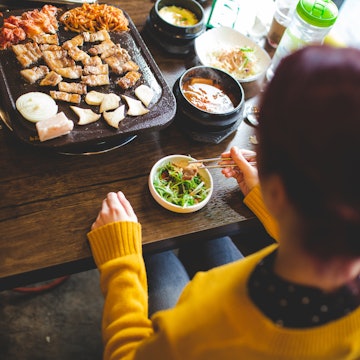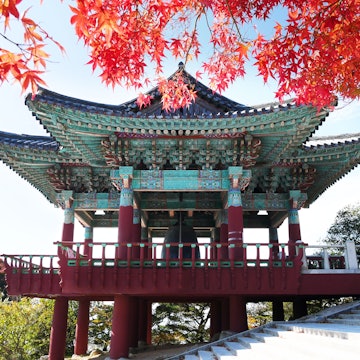
A guide to the best street food in South Korea



Sampling street food is an essential thing to do on any visit to South Korea © Boontoom Sae-Kor / Shutterstock
In South Korea, you are never far from delicious street food to satisfy your cravings. Skewers of tangy chargrilled chicken, crispy fried veggies and golden fish-shaped waffles with a sweet surprise filling can make for a full meal.
Eat Korean-style – not walking but rubbing shoulders with locals around stalls or in cozy pojangmacha (tented street restaurants) with a cup of soju (a distilled spirit). It’s an easy way to see and taste-test some Korean flavors.
Here are some of the most popular foods to sink your teeth into on the streets of South Korea.
Discover 30+ top Seoul attractions all on one pass with Go City. Pick between a 1 to 5- day All-Inclusive Pass and brave the thrill rides at Lotte World, visit the border on a Demilitarized Zone Tour, enjoy the views from N Seoul Tower, and much more!
Tteokbokki (spicy rice cakes)
If you dislike spice, look away now. Tteokbokki are rice cakes in a bright red-orange sauce that’s a mix of water, soy sauce, sugar, red chili flakes and gochujang, a paste made from fermented soybeans and red chilis that is used extensively in Korean dishes, most famously in bibimbap (rice with cooked vegetables). Well into the night, just about anywhere Koreans congregate for work, school or socializing, you will find street stalls and pojangmacha stewing oblong pans of tteok (rice cakes that resemble overblown penne pasta) in the bubbling sauce.
A mild version of tteokbokki used to be just for the royal court to eat, but now even partygoers stop on the street to fill up on the chewy rice cakes. They don’t have much flavor and almost demand the spicy and sweet sauce. Dressed-up tteokbokki variations add slices of fish cake, boiled eggs, ramyeon (ramen noodles) and other ingredients. The best place to try this is Sindang Tteokbokki Town, a collection of tteokbokki eateries in Seoul’s Sindang neighborhood, where the modern version of the dish was pioneered and popularized.
For a quick and convenient version, try tteokkochi, where the rice cakes are threaded onto a skewer.
Soondae (Korean sausage)
Soondae is one of Korea’s most popular street foods, and you’ll find it at just about every street stall and pojangmacha. But don’t think bratwurst or salami – soondae is a blood sausage that’s made from cow or pig intestine stuffed with pork blood and some combination of glass noodles, glutinous rice and vegetables.
These soft, chewy sausages are steamed, sliced and usually served with pieces of liver and lung. In Seoul, you’ll get a mix of salt, chili powder, sesame seeds and MSG to dip the sausage in, while in other regions vendors might give you a vinegar-gochujang mix or a soybean-based sauce. Lots of street eaters take a combo approach, ordering tteokbokki and soondae together and dipping their sausage in the spicy tteokbokki sauce.
If you go to Gangwon-do Province, make sure you try ojingeo soondae, which uses cooked squid instead of intestines to hold the filling.
Gimbap (rice and nori rolls)
It looks like a sushi roll, but this is gimbap: dressier, with a dried seaweed (gim) wrap and bursting with flavor you can see. The rice (bap) and seaweed are lightly flavored with sesame oil, and the rolls are given a kick with a side of kimchi. Fillings often include canned tuna or beef, spinach, carrot, imitation crab, pickled radish, egg and herbaceous Korean perilla leaf (similar to shiso).
Gimbap comes in both hefty rice-filled slices, which make for speedy hunger busters, and mouthwatering petite rolls with fewer ingredients. The smaller rolls are ubiquitous at street stalls and markets, while the larger versions are staples of the simple lunch and snack shops known as bunsik, such as the Gimbap Cheongook (Gimbap Heaven) chain. Packaged versions can also be found in convenience stores all over the country.
Dak gangjeong (seasoned fried chicken pieces)
Dak gangjeong is something of a fusion food. But what a fusion! Tender chicken pieces are coated with a sweet and spicy sauce and then sprinkled with sesame seeds and peanuts. The boneless bite-sized pieces are usually double fried, giving them a distinctive crackle. A small box is a great way to satisfy a craving. Some stalls will even offer a version sprinkled with parmesan cheese for maximum fusion.
Twigim (Korean-style tempura)
Koreans don’t tiptoe around frying their street food. Twigim are various great-tasting ingredients fried in a batter (think Japanese tempura but more substantial): succulent squid, a hash of vegetables, sweet potatoes and even boiled eggs. You will be hard-pressed to find twigim outside of Korea, so fill up.
At many street markets, you’ll come across sit-down twigim restaurants, where you use tongs to pick up the pieces you want from a buffet-style spread and place them in a basket. Pay for all of them at the cashier, and then the staff will take your basket, fry up your selection and bring your golden plate to your table. An especially good place to try twigim is Gongdeok Market in Seoul.

Mandu (dumplings)
Mandu come deliciously fried, steamed or boiled. As a street snack, the most likely choice is kimchi mandu, filled with green onion, ground pork and a lot of spicy kimchi that you can see shimmering orange through the soft skin. Kogi mandu are stuffed with gingery ground pork and green onions. These pockets of flavor are warm and delicious, but sometimes spicy enough to warrant a warning from the chef. Dumplings are typically served six or seven to a plate. Dip them in soy sauce and vinegar and chow down.
Jjinppang mandu are soft fluffy buns filled with pork, tofu, green onions and garlic. Buns just called jjinppang are a sweet version, filled with red bean paste.
Myeon (noodles)
Bowls of myeon soup might not sound like street food, but in fast-moving Korea, everything is ready for a quick meal between meals. Keep warm and satisfied in the winter by popping into a pojangmacha for a bowl of udon or janchi guksu (banquet noodles), a deeply comforting dish of thin noodles in an anchovy-based broth.

Bungeoppang and gukhwa-ppang (red bean waffles)
In any town in Korea, you'll find cute fish-shaped sweet cakes on the streets. These bungeoppang have a golden brown, waffle-like exterior that is both soft and crispy to bite into, giving way to hot sweet red bean paste. Today, many vendors also offer versions filled with things like cream or Nutella. What bungeoppang don't contain is any actual fish.
You’ll find street vendors near schools and subway stations pouring kettles of batter into molds of other shapes, too, such as chrysanthemum flowers to make gukhwa-ppang, which are also filled with red bean paste but tend to be less crispy than bungeoppang.

Hotteok (Korean doughnuts)
Hotteok are sometimes called Korean doughnuts, but they’re more like pancakes with a sweet, caramelly filling. The theater of watching vendors press the balls of dough into disks and fry them until they’re golden brown is half the pleasure. Before frying them, vendors make a hole in the dough and fill it with a mixture of cinnamon, brown sugar and peanuts, which turns into a grainy caramel as the dough fries.
It’s hot stuff and burns when you inevitably can’t wait to bite into the hefty, fragrant pancake oozing with the delicious fillings. A version called ssiat hotteok includes black sesame, sunflower and pumpkin seeds. It’s a Busan specialty. Both versions are a sweet tooth’s dream.

Gyeranppang (egg muffins)
Literally "egg bread," gyeranppang is an oblong golden muffin with a moist whole egg baked on top. It’s sometimes finished off with a dusting of parsley. You might have a hard time finding these in the summer, but once the weather cools, stalls selling gyeranppang start appearing with increasing frequency. To try the snack in its birthplace, make a pilgrimage to the port city of Incheon. Dense and comforting, savory and sweet, it's a road to addiction.
Kkochi (skewers)
Korean street vendors know that putting anything on a skewer makes street food easier to handle.
The most common type of skewer is dak-kkochi: grilled chicken and green onion skewers that hum with a smoky charred flavor under a sticky tangy barbecue sauce. Another popular snack is sotteok sotteok, which are like kebabs of mini sausages and rice cakes. If you ever wanted to eat potato chips on a stick, try hway-ori gamja (tornado potato), a potato cut into one long swirl, skewered and fried.
Odeng/Eomuk (fishcake)
Odeng are hot, easy-to-eat fishcakes typically served on a skewer. If you are spice-shy, odeng is your street-eat savior. It’s soft, smooth and only mildly fishy. The fishcake is either shaped like a hot dog or flat and folded over, and the skewers jut out from steaming vats of seafood, green onion and sometimes chili-infused broth that people sip on as they eat. It’s popular in winter, and many Koreans drink the soup alongside soju to temper the alcohol’s fire.
Odeng is self-serve. Just ladle the satisfying broth into one of the paper cups on offer and help yourself to the skewers. You'll usually find either a dish of soy sauce that you can brush onto your odeng or a spray bottle of the stuff that you can spritz on your skewer. The stall keeper counts up the sticks when you’re done. In larger places, you’ll find different colored skewers that correspond to different prices.
Hot bar (fish-cake bar)
Hot bar is a skewer of fish-cake paste that’s been mixed with ingredients like carrot, chili pepper and other ingredients and then deep-fried. More elaborate versions have hot dogs, imitation crab or cheese inside. A perilla leaf is often wrapped around the bar to add extra flavor. Hot bars are a fast-food cross between the fried snacks of twigim and odeng.

Hot dog
In Korea, this isn’t a hot dog in a bun with mustard and ketchup, but a corn dog (battered sausage). Vendors will offer squirts of ketchup, mustard and chili sauce and sometimes even a sprinkling of sugar. If you want to take things to the next level, try a gamja dog, a sausage fried in batter with a crust of French fries (yes, really). It's the kind of fun food that reminds you of being at a fairground.















